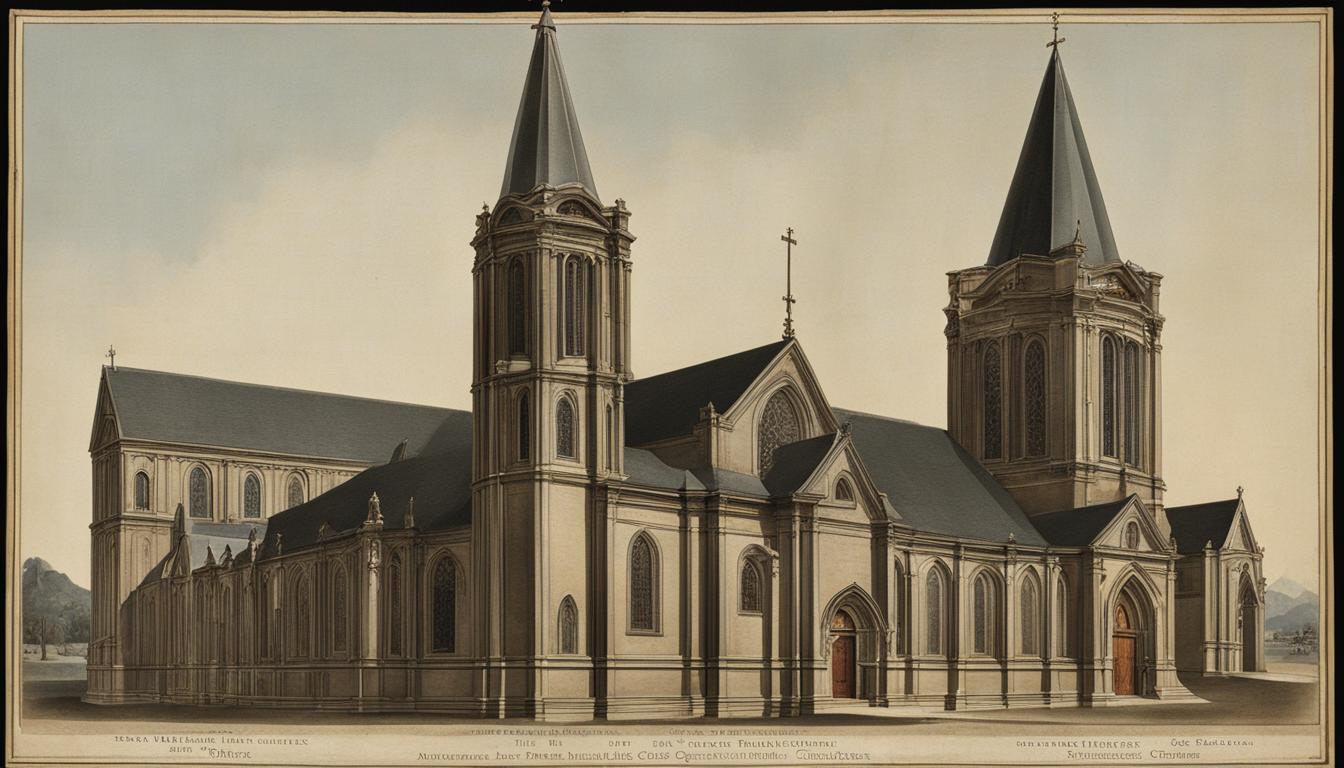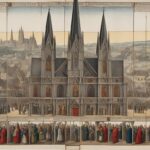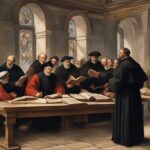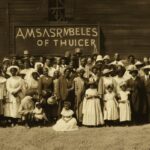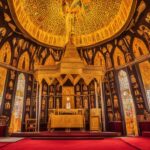The United Methodist Church has a storied history, rooted in the vibrant Methodist movement and the visionary leaders who shaped its foundations. Dating back to 1730, the origins of the United Methodist Church can be traced to John and Charles Wesley, who formed a small group at Oxford University in England, seeking to deepen their faith and spread the teachings of Methodism.
Across the Atlantic, the Methodist movement took hold in America as well, led by Philip William Otterbein and Martin Boehm. The fervor of their preaching and commitment to practical Christianity resulted in the formation of the United Brethren in Christ Church. Over time, these two movements merged, along with other Methodist denominations, culminating in the establishment of The United Methodist Church in 1968.
Key Takeaways:
- The United Methodist Church traces its roots back to the Methodist movement, initiated by John and Charles Wesley at Oxford University in England.
- The formation of the United Methodist Church was a culmination of merging Methodist denominations and the United Brethren in Christ Church.
- The Methodist movement in America was led by Philip William Otterbein and Martin Boehm and eventually resulted in the formation of the United Brethren in Christ Church.
Beliefs and Doctrines of the United Methodist Church
The United Methodist Church is firmly rooted in Wesleyan theology, which encompasses a set of beliefs and doctrines that guide the denomination’s faith and practice. These principles, formed by the teachings of John Wesley, emphasize the core tenets of salvation by grace through faith, justification, and holiness.
At the heart of Methodist beliefs is the understanding that salvation is a gift from God, received through faith in Jesus Christ. It is not something that can be earned or achieved through human efforts alone. This emphasis on grace is a central aspect of the Methodist tradition, highlighting God’s unmerited love and forgiveness for all.
In line with Wesleyan theology, the United Methodist Church recognizes the triune nature of God, affirming the belief in one God who exists in three persons: the Father, the Son (Jesus Christ), and the Holy Spirit. This understanding of God’s nature shapes the denomination’s worship, prayers, and theological understanding.
The divinity of Jesus Christ is another essential doctrine within the United Methodist Church. Methodists believe that Jesus is the Son of God, fully divine and fully human. Through his life, death, and resurrection, Jesus offers salvation to all who believe in him.
The United Methodist Church also affirms the power and work of the Holy Spirit in the lives of believers. The Holy Spirit is seen as the presence of God within individuals and the Church, guiding, empowering, and transforming followers of Christ.
Scripture, particularly the Bible, holds authoritative significance within the United Methodist Church. Methodists view the Bible as the inspired word of God, providing guidance, instruction, and wisdom for faith and life. It serves as a foundation for theological reflection and understanding.
As a denomination, the United Methodist Church is committed to promoting social justice and inclusivity. Guided by the teachings of Jesus, Methodists seek to address issues of injustice, advocate for the marginalized, and work towards a more equitable society. The denomination also recognizes the importance of personal and social holiness, calling its members to a life of faithfulness, righteousness, and love.
To illustrate the key beliefs and doctrines of the United Methodist Church, let’s take a closer look at some of the fundamental principles:
- Salvation by Grace through Faith: Methodists believe that individuals are saved by God’s grace through faith in Jesus Christ.
- Justification: The United Methodist Church holds that justification is a gift from God, whereby individuals are forgiven and reconciled to God, establishing a new relationship characterized by love and obedience.
- Holiness: Methodists emphasize the pursuit of holiness in both personal and social contexts. This involves striving for righteousness, love, and justice, as guided by the Holy Spirit.
- Triune Nature of God: The United Methodist Church affirms the belief in one God who exists in three persons: the Father, the Son (Jesus Christ), and the Holy Spirit.
- Divinity of Jesus Christ: Methodists believe that Jesus is the Son of God, fully divine and fully human, and that through him, salvation is made available to all.
- Authority of Scripture: The Bible is regarded as the inspired word of God and holds authoritative significance in matters of faith, doctrine, and practice.
- Social Justice and Inclusivity: The United Methodist Church is committed to promoting social justice, engaging in acts of compassion, and advocating for the equal rights and dignity of all people.
This exploration of the beliefs and doctrines of the United Methodist Church sheds light on the core principles that shape the denomination’s theology and spirituality, anchoring its members in the rich heritage of Wesleyan theology.
Core Beliefs and Doctrines of the United Methodist Church
| Beliefs and Doctrines |
|---|
| Salvation by Grace through Faith |
| Justification |
| Holiness |
| Triune Nature of God |
| Divinity of Jesus Christ |
| Authority of Scripture |
| Social Justice and Inclusivity |

Sacraments and Rituals in the United Methodist Church
In the United Methodist Church, sacraments and rituals hold a special place in the worship experience. They serve as essential means of grace and opportunities for believers to connect with God and their fellow congregants. The two sacraments observed in the United Methodist Church are baptism and Holy Communion.
Baptism: A Symbol of Initiation
Baptism in the United Methodist Church is a significant sacrament that symbolizes initiation into the Christian community and an individual’s commitment to living a life of faith. It is seen as a means of grace, a moment where God’s love and forgiveness are experienced.
Through the act of baptism, individuals publicly profess their faith and are welcomed into the United Methodist Church family. It is a joyous occasion celebrated by the congregation, marking the beginning of a lifelong journey of discipleship.
Holy Communion: A Sacred Commemoration
Holy Communion, also known as the Eucharist or the Lord’s Supper, is another sacrament observed by the United Methodist Church. It is a commemoration of Jesus’ Last Supper with his disciples and a way for believers to experience his presence in their lives.
During Holy Communion, bread and grape juice are shared among the congregation, symbolizing the body and blood of Jesus Christ. It is a solemn and sacred ritual that encourages reflection, gratitude, and spiritual nourishment.

Rituals and Worship Practices
In addition to the sacraments, the United Methodist Church has various rituals and worship practices that enhance the spiritual journey of its members. These practices create a sense of unity, foster collective worship, and provide opportunities for personal reflection.
Liturgical worship is a hallmark of Methodist worship services, featuring structured and intentional elements that guide the congregation through different stages of worship. It often includes prayers, responsive readings, hymn singing, and Scripture readings.
Hymns play an integral role in Methodist worship, as they are not only a means of expressing praise but also vehicles that carry theological teachings and traditions. Hymn singing is a cherished practice that unites the congregation in worship and strengthens their faith.
Prayer is a central component of Methodist worship, allowing individuals to communicate with God, seek guidance, and intercede on behalf of others. It is a time of intimate connection with the divine and a way to express gratitude, concerns, and hopes.
“The liturgical rituals and worship practices in the United Methodist Church provide a sacred framework for believers to encounter God, experience His love, and grow in their faith.”
As followers of Christ, United Methodists embrace these sacraments and rituals as profound expressions of their faith and devotion. They serve as reminders of God’s grace, sources of spiritual renewal, and opportunities for believers to forge deeper connections with God and one another.
Leadership and Clergy in the United Methodist Church
The United Methodist Church is guided by a structured and hierarchical leadership system that ensures the smooth functioning of the denomination. At the helm of this structure are the bishops, who provide spiritual and administrative oversight.
The role of a bishop is critical in the United Methodist Church as they are responsible for nurturing the faith of the congregation, leading the clergy, and providing guidance and support to the local churches. Bishops are elected by the Jurisdictional Conferences, which are regional gatherings of pastors and lay delegates.
The United Methodist Church also has a diverse group of clergy who serve at various levels within the denomination. Elders, or ordained clergy, play a crucial role in leading and guiding the congregations. They are responsible for preaching, teaching, and offering pastoral care to the members of the church.
Deacons, on the other hand, are ordained ministers who are called to serve communities inside and outside the church. They often focus on ministries of compassion, justice, and service, and work closely with the local congregations to address the needs of the community.
Additionally, the United Methodist Church recognizes and values the role of local pastors. These are licensed individuals who have been trained in ministry and are approved to serve as pastors in specific congregations. They play a vital role in leading worship services, providing pastoral care, and facilitating the spiritual growth of their congregations.
Throughout the United Methodist Church, the clergy’s mission is to serve as spiritual leaders, guiding the faithful on their journey of faith. They provide support, guidance, and counsel to the members of the congregation, helping them navigate the challenges of life and grow in their relationship with God.
The role of pastors in the UMC goes beyond providing spiritual guidance. They actively engage in community outreach, social justice initiatives, and advocacy for those in need. Through their leadership and service, Methodist clergy strive to make a positive impact in the lives of individuals and communities, following in the footsteps of Jesus Christ.
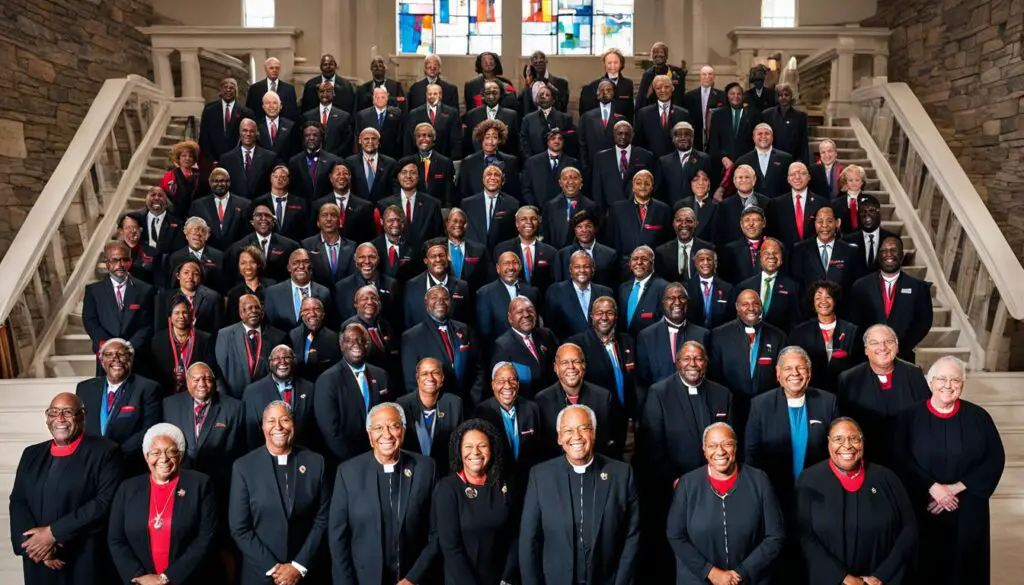
Key Points:
- The United Methodist Church has a hierarchical structure with bishops providing spiritual and administrative leadership.
- Elders, deacons, and local pastors are vital clergy positions within the UMC.
- The clergy’s role involves guiding congregations, providing pastoral care, and engaging in community outreach.
“The United Methodist Church is blessed to have dedicated and passionate clergy who serve with humility and devotion, nurturing the faith of the believers and making a meaningful impact in the world.” – Rev. Sarah Johnson
Worship Practices in the United Methodist Church
The United Methodist Church embraces liturgical worship, which follows a structured order of service designed to deepen the spiritual connection between congregants and God. These worship services are characterized by their reverence, community engagement, and active participation.
“In worship, we gather as a faith community to offer our praise, prayers, and thanksgiving to God,” says Reverend Sarah Thompson, a United Methodist pastor. “It is a time for us to draw near to God and experience His presence in a powerful way.”
During Methodist worship services, congregants engage in various practices and traditions that strengthen their spiritual journey:
- Prayers: Prayers play a central role in Methodist worship services. They offer an opportunity for individuals to communicate with God, express gratitude, seek guidance, and intercede for others.
- Scripture Readings: Reading from the Bible is an essential part of Methodist worship. The congregation listens attentively to selected passages, often centered around a specific theme or sermon.
- Hymn Singing: Hymns hold a special place in Methodist worship. United Methodist churches are known for their rich musical heritage, and hymn singing serves as a way to praise God, reflect on His grace, and deepen spiritual connections within the community. The powerful lyrics and melodies inspire congregants in their devotion.
- Sermons: Sermons provide spiritual guidance and biblical teachings. United Methodist pastors and guest speakers deliver messages that explore the Scriptures, offer insights on Christian living, and address relevant issues in society.
- Celebration of Sacraments: The United Methodist Church practices two sacraments: baptism and Holy Communion. Baptism symbolizes initiation into the Christian community and is seen as a means of God’s grace. Holy Communion, also known as the Eucharist or the Lord’s Supper, is a commemoration of Jesus’ Last Supper and a time of connection with His presence.
United Methodist worship services aim to create a sacred space where congregants can engage with God, reflect on their faith, and find spiritual nourishment. The emphasis on congregational participation encourages active involvement, fostering a sense of community and worshipful unity.
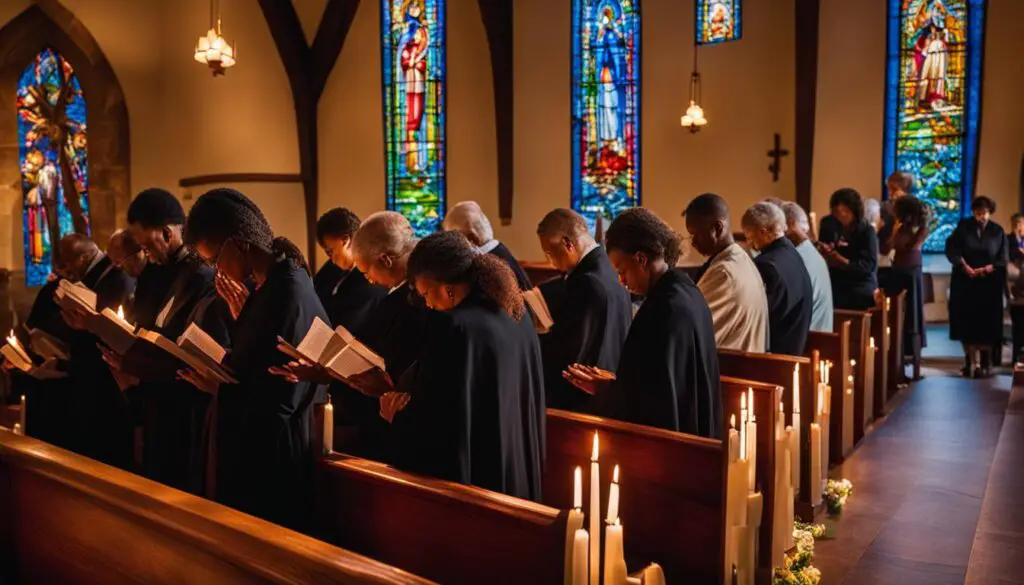
Sacred Texts in the United Methodist Church
The United Methodist Church holds the Bible as its primary sacred text, considering it to be the inspired word of God. The Scriptures play a central role in shaping the beliefs, practices, and teachings of the denomination. They serve as a guide for personal and communal faith, providing wisdom and insight into the nature of God and the relationship between God and humanity.
As John Wesley, the founder of Methodism, once said:
“I am a Spirit-led man of one book, and one book only. The Bible is my sacred text, my source of truth, my compass in this life and the next.”
Within the United Methodist Church, Scripture is seen as the foundation of faith and the ultimate authority for doctrine and moral living. The denomination encourages its members to engage with the Bible through regular reading, study, and reflection.
“The Bible is a lamp to my feet and a light to my path.”
While the Bible holds supreme importance, the United Methodist Church also acknowledges the value of tradition, reason, and experience in interpreting Scripture.
The Wesleyan quadrilateral is an approach used by Methodists to engage with sacred texts. It incorporates four distinct sources of authority: Scripture, tradition, reason, and experience. This holistic approach to interpretation helps Methodists to gain a deeper understanding of the biblical message and its practical application in today’s world.
Furthermore, the United Methodist Church recognizes the significant contributions of John Wesley, not only as a founder but also as a prolific writer and theologian. His writings, sermons, and commentaries continue to shape Methodist beliefs and practices, serving as important resources for spiritual growth and theological exploration.
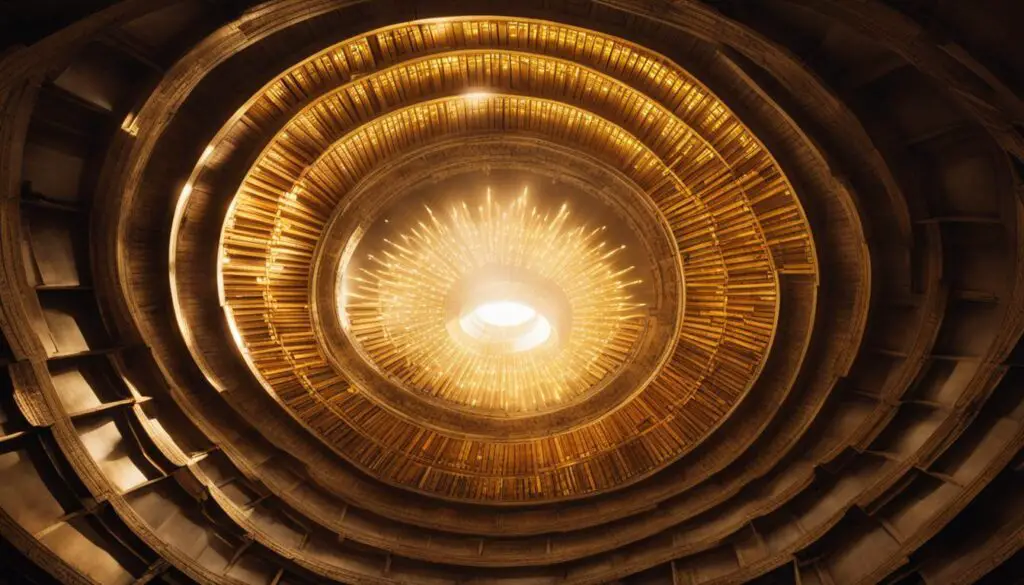
| Key Points | Benefits |
|---|---|
| The Bible is the primary sacred text in the United Methodist Church. | Guides personal and communal faith, provides understanding of God’s nature and human relationship with God. |
| Wesleyan quadrilateral: Scripture, tradition, reason, and experience. | Helps interpret Scripture in a holistic manner, considering various sources of authority. |
| John Wesley’s writings and teachings. | Contribute to Methodist beliefs and practices, offer spiritual growth and theological insight. |
Denominations and Sects within the United Methodist Church
Within the broader umbrella of the United Methodist Church, there are various denominations and sects that share common roots and beliefs. These groups, while distinct in some theological and organizational aspects, are united by the Wesleyan traditions they hold dear. Let’s explore some of the prominent denominations and sects within the United Methodist Church.
The African Methodist Episcopal Church
- Year Established: 1816
- Membership: 2.5 million
The African Methodist Episcopal Church (AME Church) was founded by Richard Allen and was the first independent black denomination in the United States. The AME Church emphasizes social justice and community empowerment through faith.
The Free Methodist Church
- Year Established: 1860
- Membership: 74,000
The Free Methodist Church was born out of a desire for a holiness movement within the Methodist Church. It promotes the teachings of John Wesley and emphasizes the life-transforming power of the Holy Spirit. The Free Methodist Church is known for its commitment to social justice and outreach.
The United Methodist Church
- Year Established (as the United Methodist Church): 1968
- Membership: 6.8 million in the United States, with a global presence
The United Methodist Church is the largest denomination within the broader Methodist tradition. It emerged from a merger of the Methodist Church and the Evangelical United Brethren Church in 1968. The UMC is committed to Wesleyan theology and embodies a wide range of theological perspectives within its diverse congregations.
These are just a few examples of the denominations and sects within the United Methodist Church. Each group contributes to the vibrant tapestry of faith and practice within the Methodist family. Despite their nuanced differences, these denominations and sects share a common commitment to spreading the love of Christ and nurturing communities of faith.
Community and Outreach in the United Methodist Church
The Methodist community is built on a foundation of love, compassion, and service to others. From its humble beginnings, the United Methodist Church continues to prioritize community engagement and outreach as integral aspects of its mission. Through a wide range of ministries and outreach programs, the Methodist community tirelessly works towards making a positive impact on the lives of individuals and communities in need.
United Methodist Church ministries span various areas of focus, including education, healthcare, social justice, and disaster relief. These ministries aim to address the needs of society, both locally and globally. They provide opportunities for members of the Methodist community to actively participate in making the world a better place. Methodist outreach programs offer support, resources, and services to those who are marginalized, vulnerable, or facing challenging circumstances.
Educational Initiatives
The United Methodist Church places a strong emphasis on education, as it believes in the transformative power of knowledge. Through its educational initiatives, the Methodist community strives to create equal opportunities for all individuals, regardless of their socio-economic background. Methodist schools, colleges, and universities provide quality education that nurtures intellectual growth, character development, and spiritual formation.
Healthcare and Well-being
The United Methodist Church is committed to promoting healthcare and well-being as fundamental rights for every individual. Methodist healthcare ministries aim to provide accessible and affordable healthcare services to all, irrespective of their financial means. Built on the principles of compassion and healing, these ministries not only address physical ailments but also attend to the emotional and spiritual needs of individuals.
Social Justice and Advocacy
The United Methodist Church advocates for social justice by standing up against inequality, discrimination, and injustice. Through its social justice initiatives, the Methodist community seeks to address systemic issues and promote a more equitable and inclusive society. These efforts include raising awareness, advocating for policy changes, and supporting organizations and movements that champion social justice causes.
Disaster Relief and Recovery
The Methodist community understands the devastating impact natural disasters can have on communities. Methodist outreach programs actively participate in disaster relief efforts, providing immediate assistance and ongoing support to those affected by catastrophes. These programs help communities recover and rebuild, offering resources for shelter, food, clean water, and emotional support during the difficult times following a disaster.
Global Missions and Cross-cultural Partnerships
The United Methodist Church is a global denomination with a strong commitment to supporting missions around the world. Through global missions and cross-cultural partnerships, Methodist communities work collaboratively towards social transformation and spiritual renewal. These missions focus on strengthening local communities, sharing resources, and fostering mutual understanding and respect across diverse cultures and backgrounds.
Through its dedication to community and outreach, the United Methodist Church continues to make a meaningful difference in the world. By following the teachings of Jesus and embodying the spirit of Wesleyan theology, Methodists embrace the call to love and serve others. As followers of Christ, they are motivated to build a more just, compassionate, and inclusive world.
Architectural and Artistic Features of United Methodist Churches
United Methodist churches are not only places of worship, but also showcase stunning architectural and artistic elements that reflect the beauty and significance of the denomination. Methodist church architecture is often characterized by a harmonious blend of traditional and modern design elements.
One of the most captivating features found in United Methodist churches is the presence of stained glass windows. These windows depict various scenes from the Bible, showcasing vivid colors and intricate designs. These artful creations not only add aesthetic value to the church interiors but also serve as visual representations of important biblical events or spiritual themes.
Another notable architectural feature in many Methodist churches is the presence of bell towers. These towers not only serve as a distinctive external element but also symbolize the calling to prayer and worship. Their presence adds a sense of grandeur and reverence to the church building, creating a visual focal point for both congregation members and passersby.
Woodwork is yet another element that contributes to the architectural beauty of United Methodist churches. From intricately carved altars to finely crafted pews and pulpit furniture, the use of woodwork reflects the craftsmanship and attention to detail prevalent in Methodist church design. These features create a warm and inviting atmosphere, enhancing the overall worship experience.
In addition to architectural elements, many United Methodist churches also showcase artwork and symbols that hold deep meaning for the denomination. These may include paintings, sculptures, or symbolic representations of the cross, flame, or dove, all of which reflect the Methodist beliefs and history.
Overall, the architectural and artistic features found in United Methodist churches serve as a visual expression of faith, heritage, and spirituality. They create an atmosphere that uplifts and inspires worshipers, inviting them to connect with their faith and reflect on the beauty and grace of God.
Contemporary Issues and Challenges Facing the United Methodist Church
While the United Methodist Church stands strong in its beliefs and traditions, it also faces a range of contemporary issues and challenges that require thoughtful consideration and action. These challenges encompass both internal debates and external societal pressures, and the denomination must navigate them while staying true to its values and principles.
Inclusion and Equality
One of the main controversies within the United Methodist Church is the ongoing debate over LGBTQ inclusion. This issue has sparked contentious discussions around same-sex marriage as well as the ordination and inclusion of LGBTQ clergy and members. The denomination continues to grapple with finding common ground on this matter, seeking to balance inclusivity and diverse viewpoints within its structure and policies.
Gender Equality
Another important topic of discussion is the ordination of women. While the United Methodist Church has made progress in this area, some congregations still struggle with accepting women in leadership positions. The ongoing dialogue centers around empowering women within the church, recognizing their valuable contributions and ensuring equal opportunities for ministry.
Racial Inequality
The United Methodist Church acknowledges its historical involvement in racial discrimination and is actively working towards racial reconciliation. Efforts have been made to address systemic racism within the denomination and promote diversity and inclusivity. However, the church continues to explore ways to dismantle racial barriers and promote equality within its congregations and communities.
Membership Decline
Like many mainline Christian denominations, the United Methodist Church is facing challenges associated with declining membership. Changing societal dynamics, shifts in religious practice, and generational differences all contribute to the decline. The denomination must find innovative ways to engage with and attract new members while nurturing the spiritual growth of existing congregations.
Relevance in a Changing Society
In an increasingly secular and diverse society, the United Methodist Church must grapple with maintaining its relevance. The denomination faces the challenge of effectively communicating its message and values to a broad audience while addressing the evolving needs and perspectives of the communities it serves. This requires adaptability, inclusivity, and a willingness to engage with contemporary social issues.
Despite these challenges, the United Methodist Church remains committed to addressing them with grace, compassion, and a steadfast dedication to its core beliefs. By fostering open dialogue, seeking common ground, and actively responding to the needs of its members and society, the denomination strives to navigate these issues while staying true to its mission of faith, justice, and love.
| Contemporary Issues | Challenges |
|---|---|
| LGBTQ Inclusion | Debates over same-sex marriage, ordination of LGBTQ clergy, and inclusion of LGBTQ members |
| Gender Equality | Continued discussions on the role of women in leadership positions and ministry |
| Racial Inequality | Addressing historical racial discrimination and promoting diversity and inclusivity |
| Membership Decline | Responding to changing religious dynamics and attracting new members |
| Relevance in a Changing Society | Communicating effectively and engaging with contemporary social issues |
Conclusion
In conclusion, the United Methodist Church stands as a testament to the rich history and enduring spirit of the Methodist movement. From its humble beginnings in the 18th century to its present-day presence, the denomination has remained steadfast in its commitment to Wesleyan beliefs and practices. The United Methodist Church continues to adapt to the challenges of the modern world, embracing inclusivity, social justice, and an unwavering dedication to faith and service.
Through its worship practices, sacraments, and rituals, the United Methodist Church nurtures a deep sense of spiritual connection and community among its members. This dedication to communal worship is complemented by a robust leadership structure, which empowers clergy and leaders to guide congregations and serve as beacons of inspiration and guidance.
United Methodist churches not only provide places of worship but also serve as important community hubs. Through outreach programs and ministries, the denomination actively engages in making a positive impact by addressing societal challenges and advancing the principles of social justice and equality. The architectural and artistic features of United Methodist churches further exemplify the devotion to faith, with their intricate designs and symbolic artwork serving as visual reminders of Methodist traditions and beliefs.
Despite contemporary issues and challenges, the United Methodist Church remains steadfast, evolving, and embracing change while holding true to its foundational principles. By navigating the complexities of the modern world with faithful determination, the United Methodist Church continues to inspire and uplift individuals, communities, and society as a whole.
FAQ
What is the history of the United Methodist Church?
The United Methodist Church has a rich history that dates back to 1730, when John and Charles Wesley formed a small group of students at Oxford University in England, seeking to spread the Methodist movement. Around the same time, Philip William Otterbein and Martin Boehm were leading similar movements in America, which eventually led to the formation of the United Brethren in Christ Church. Over the years, these movements merged and grew, leading to the creation of The United Methodist Church in 1968.
What are the beliefs and doctrines of the United Methodist Church?
The United Methodist Church is rooted in Wesleyan theology, which emphasizes the concepts of salvation by grace through faith, justification, and holiness. They believe in the triune nature of God, the divinity of Jesus Christ, the power of the Holy Spirit, and the authority of Scripture. The denomination promotes social justice, inclusivity, and the importance of personal and social holiness.
What sacraments and rituals are practiced in the United Methodist Church?
The United Methodist Church practices two sacraments: baptism and Holy Communion. Baptism is seen as a means of grace and a symbol of initiation into the Christian community. Holy Communion, also known as the Eucharist or the Lord’s Supper, is a commemoration of Jesus’ Last Supper and a way to experience his presence. The denomination also has various rituals and worship practices, such as liturgical worship, hymn singing, and prayer.
What is the leadership structure and role of clergy in the United Methodist Church?
The United Methodist Church has a hierarchical structure with bishops overseeing the administration of the denomination. Bishops are elected by the Jurisdictional Conferences and serve as spiritual and administrative leaders. The UMC also has elders, deacons, and local pastors who play vital roles in leading congregations and providing pastoral care.
What are the worship practices and traditions of the United Methodist Church?
The United Methodist Church embraces liturgical worship and has a structured order of service. Worship services often include elements such as prayers, Scripture readings, hymn singing, sermons, and the celebration of sacraments. The denomination values congregational participation and encourages active engagement in worship.
What are the sacred texts in the United Methodist Church?
The primary sacred text of the United Methodist Church is the Bible, which is considered the inspired word of God. The UMC follows a Wesleyan quadrilateral approach to interpreting Scripture, which includes Scripture, tradition, reason, and experience. The denomination also values the writings and teachings of John Wesley, the founder of Methodism.
What are the different denominations and sects within the United Methodist Church?
Within the broader umbrella of the United Methodist Church, there are various denominations and sects. These include the African Methodist Episcopal Church, the Free Methodist Church, and the United Methodist Church itself. While these denominations share common roots and beliefs, they may have slight theological and organizational differences.
What community and outreach initiatives are there within the United Methodist Church?
The United Methodist Church is known for its strong sense of community and commitment to serving others. The denomination engages in various ministries and outreach programs, focusing on areas such as education, healthcare, social justice, and disaster relief. The UMC also supports global missions and cross-cultural partnerships.
What architectural and artistic features are found in United Methodist churches?
United Methodist churches often exhibit unique architectural and artistic features. These may include traditional church buildings with bell towers, stained glass windows depicting biblical scenes, and intricate woodwork. Many churches also have artwork and symbols that reflect Methodist beliefs and history.
What are the current issues and challenges facing the United Methodist Church?
Like any denomination, the United Methodist Church faces contemporary issues and challenges. These may include debates over LGBTQ inclusion, discussions on the ordination of women, and addressing racial inequality. The UMC also grapples with issues related to declining membership and relevance in a changing society.





